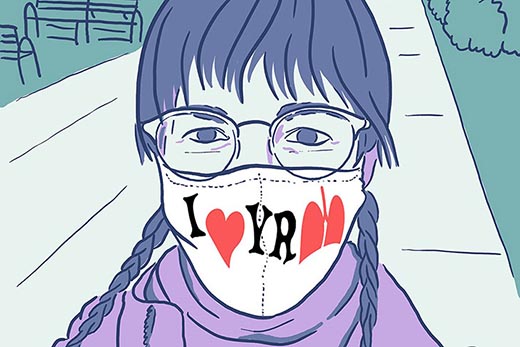RIT Students Cope with Pandemic Through Graphic Medicine
Press release from the issuing company
Comics and narratives to be produced in weekly fall course

A self-portrait of Artist Kriota Willberg, a cartoon artist and illustrator. She’s teaching a course in Graphic Medicine, where RIT students can draw their experiences during this COVID-19 pandemic, through COLA’s Center for Engaged Storycraft and the School of Individualized Study.
Rochester Institute of Technology students this fall can have a creative outlet to help them reflect on their experiences during the COVID-19 pandemic by producing comics and visual arts narratives.
“The pandemic has impacted every aspect of our lives,” said Kriota Willberg, a New York City-based comic artist and illustrator who will be teaching the three-credit weekly online workshop called “Graphic Medicine,” being offered by the School of Individualized Study and the Center for Engaged Storycraft in the College of Liberal Arts.
“Everyone, regardless of who they are, has stories to tell about their fear of infection, coping with social distancing, the loss of family and friends, witnessing prejudice or racism, seeking healthcare, loss of work, changing relationships, fluctuating mental and physical states, hope for treatment or vaccine, and more. All of these stories qualify as graphic medicine,” Willberg said.
The workshop will also explore the history of visual arts and drawing graphic narratives as a way artists can resonate with epidemics. She said over the centuries, pandemics have caused similar patterns of disruption and “graphic medicine” – comics about health, health justice, illness, medicine, healthcare, the mind and body – is an emerging area of comics that is relevant to all of us at this time.
“We will explore contemporary and historical graphic narratives about epidemics and pandemics and practice making our own narratives using text and images,” Willberg said. “We will be creating diary, educational and fictional comics, and other types of image-based stories.”
Students in the workshop must have competency in basic drawing techniques; it is recommended for students studying art and design, illustration, animation or medical illustration.
“I truly wish that COVID-19 was not ravaging the world, but our struggle with this virus gives us an opportunity to reflect, engage, and grow by helping us understand our experiences, giving us empathy for others, arguing for justice and engaging with the world and one another in new and meaningful ways,” she said. “Making graphic medicine can facilitate that growth.”
Willberg visited RIT last year to lead workshops with students from English, performing arts and visual culture and medical illustration departments, as well as being part of a lecture series, “Stories of Health Care from the Field,” organized by the Center for Engaged Storycraft.
The center is offering two other unrelated one-credit storycraft workshops in the fall. One is about telling the story of addiction and recovery, and the other focuses on making virtual reality experiences and will be held the MAGIC VR Lab on campus.
For more information on any of these workshops, contact Laura Shackelford, director of the Center for Engaged Storycraft, at [email protected].
© 2025 WhatTheyThink. All Rights Reserved.













